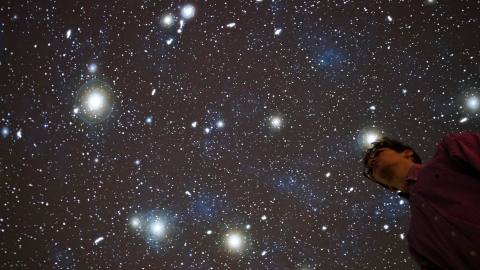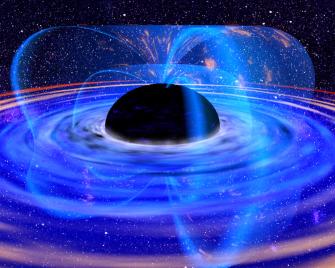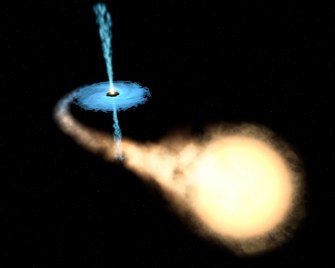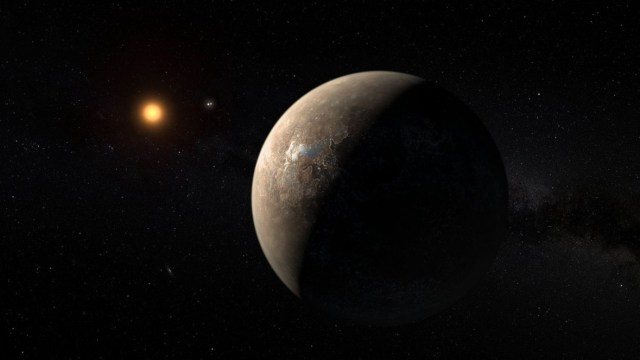You Could You Be Surrounded by Tiny Black Holes and Not Even Know it

Ever been attacked by a cadre of tiny black holes? Few of the well-adjusted would answer yes seriously. And yet, according to physicists the occurrence is not outside the realm of possibility. The universe may actually contain a multitude of tiny black holes careening through space perhaps on their own, or even in swarms. Though small, they are no less significant. Some of these could weigh as much as your average asteroid. At their heaviest, they would weigh a little less than the moon. Yet in physical size they would be tiny, 0.25 millimeters in diameter, around the size of a decimal point or the width of a human hair.
The good news is, astrophysicists have a pretty good handle on what most of the universe is composed of. One staggering drawback though, they are running out of explanations for what remains. This could turn into a “crisis of science,” according to Alexander Kashlinsky, a cosmologist at NASA. 20% of our universe is made up of your run-of-the-mill matter, while 80% of mysterious dark matter, which we know very little about. We know that it exerts some weak gravity on normal matter. That’s about it.

A black hole observed by astronomers.
Unfortunately, all attempts over the last 80 years to understand dark matter or locate it, either in space or on Earth, has turned up bupkis. Now, scientists are running out of options. Astrophysical or stellar-mass black holes, as the tiny variety are called, are for some the last refuge for averting such a crisis. The idea of miniscule black holes careening through space is not the leading theory. It’s on the fringe. Most astrophysicists believe that dark matter exists. It’s just the particle that makes it up has proven more elusive than expected.
The black holes we know of are generally pretty heavy. Most are 20-100 times as massive as our sun. Recently, scientists were able to measure gravitational waves when two black holes, average in size—each 30 times the mass of our sun, collided. Through studying this event, the tiny black hole theory got a boost. Some researchers believe that the second after the Big Bang took place, miniature black holes were formed. Just as life on Earth is thought to be born out of a primordial soup, so too would these tiny black holes be born out of a “particle soup.” Kashlinsky suggests that these “primordial” black holes would be tiny yet travel in swarms.

A star-sized black hole detected by the Hubble Space Telescope.
Astrophysicist Timothy Brandt with the Institute for Advanced Study, said they could be at their smallest tinier than an atom. Brandt told Business Insider these microscopic black holes might pass between the Earth and the sun once every 100 million years, give or take. They would be difficult to detect. If you were right near it you may be able to see it. So what would happen if you accidentally touched it? It would be something like being hit with a bullet, but with tidal forces which would deform you. You would also burn up due to the incredible heat. Doesn’t sound like a nice way to go, but fitting for a video-game boss character, or a sci-fi villain. Brandt called the possibility of quantum black holes visiting Earth “absurdly unlikely.” Yet, if such a thing occurred he admitted, “It would cause some havoc.”
Other researchers believe that stellar-mass black holes pass through Earth all the time, without incident. Aaron VanDevender, a researcher at Halcyon Molecular, in California, and his father, J. Pace VanDevender, of Sandia National Laboratories, in New Mexico, hold this view. They think one or two quantum black holes pass through the Earth daily. These are miniscule, tinier than atoms. Astronomer Massimo Ricotti, of the University of Maryland, agrees. He said that these black holes are so small, they are unlikely to disrupt atoms. “Even if they’re moving through a solid body, most of the time they find themselves almost in a vacuum, given their small size,” he said.
In this view, instead of trapping a lot of matter, they may occasionally take atoms with them in their orbits. Once they acquire such atoms, they are called Gravitational Equivalents of an Atom (GEAs). These black holes are very different from their distant big cousins dotting the vastness of space. GEAs have such small event horizons or cone-shaped mouths, and are so small, that they have little chance of sucking anything in.

3D map of a distribution of dark matter, reconstructed from measurements taken by the Hubble Telescope. Image by NASA/ESA/Richard Massey (California Institute of Technology)
There are some other theories, such as one put out last year in the journal Physical Review Letters, that mini-black holes could cause bubbles that disrupt the Higgs field. That’s an energy field made up of Higgs boson particles out in space. If these tiny black holes interacted with it, it could collapse the vacuum of space, which, no big deal, would destroy the entire universe! Most scientists tell us not to worry. And some well-known theorists take extreme umbrage with this view. Another theory states that all particles could, in fact, be variations of primordial black holes.
Some physicists even suggest that dark matter is comprised of GEAs, just as matter itself is made up of atoms. But these black holes with particles revolving around them, are just one of a number of other particles hypothesized to make up dark matter. No one will know until the right particle is identified, perhaps through experiments with a particle accelerator, such as the one found at CERN. For scientists, the most worrisome possibility is that mini-black holes are just so small and the effect of their gravity so weak, that they are near impossible to detect. And this might set science back. For how might one detect a microscopic black hole?
Want to learn what would happen if a black hole the size of a coin landed near you? Click here:





